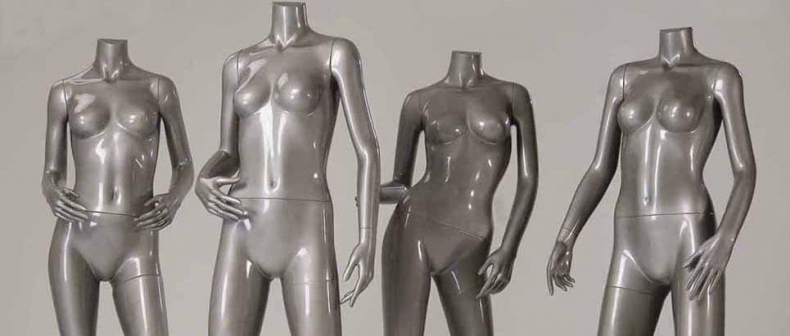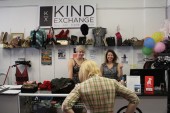
July Legaspi is not satisfied with his window. He moves her stiff body a little to the right, yanking on her headless neck for leverage. She’s probably close to thirty pounds. Maybe it’s her white jacket. He brushes off her shoulders. Behind the glass, Legaspi is the only body that moves voluntarily.
He runs a clothing steamer along a bright red “sale” poster to remove any wrinkles–treated no differently than the clothing on the three stationary figures he’s surrounded by. He comes out of the store to examine his creation. He walks away, and then on his way back pretends to be a passerby seeing it for the first time. After several minutes he heads back inside, grabs a stepladder and begins rolling the freshly steamed sale sign up from the bottom, like a giant scroll. Underneath he reveals a new image: a model, smiling, almost as lifeless as the mannequins that accompany her.
Blame Legaspi and people like him for that awkward experience in the fitting room when you think, It looked better on the mannequin; because in reality, it probably did. Legaspi, 26, is a visual merchandiser at Banana Republic Women in Toronto’s Eaton Centre. He makes clothes look better than they actually are, so people will buy them. A visual merchandiser has a close relationship with the mannequin (being repeatedly undressed by someone over a long period of time will do that), the silent seller that can draw you into store after store using nothing but its good looks.
Stores have used mannequins since the Industrial Revolution, when dressing one was up to employees who had no previous training. They were referred to as “window trimmers.” Now, directives come from headquarters of large companies like Banana Republic, and visual merchandisers must pore through paperwork with instructions as specific as what leg-bend on the mannequin to use. The role of visual merchandising is now such an essential part of sales, that hopefuls even pursue college diplomas and university degrees to find employment as one.
In Seneca College’s two-year visual merchandising arts program, students learn how to draw, cut straight lines with knives, dress mannequins, create effective lighting, and to construct a visually pleasing window display. One-week field placements at some of the top clothing stores in terms of window displays–Harry Rosen or FCUK, say–let students shadow talented visual merchandisers. At the end of two years, they show off their own skills at a show called “Redefining Design,” in which they build a window display using merchandise sold in stores like William Ashley’s on Bloor Street.
A well-dressed mannequin doesn’t magically appear overnight, ‘magically’ being the operative word. Catherine Emek, visual merchandising supervisor for Banana Republic Women, proves that the magic starts as early as 8 a.m. Upon starting her day, she knows that her team of five will have to do “an overnight” because the store is planning a markdown. Two of Emek’s employees are in the stockroom grabbing their final bite of breakfast before a long day’s work. In here, it looks like a mannequin’s walk-in closet, with endless racks of clothing to choose from. The store won’t open for another hour, but there is lots of work to do. Emek, 24, is a graduate from Ryerson University’s retail management program. She’s responsible for creating effective, brand-appropriate windows that generate sales–the bottom line in this job.
“You can do a fantastic window, but if you don’t sell the merchandise that’s on the fixtures or on the mannequin, you really haven’t done your job,” says David McDermid, program coordinator of visual merchandising arts at Seneca. “The only reason retailers will hire us and keep us is if sales are moving from the window.”
Windows are typically changed once every two months, but usually left no longer than three weeks. A visual merchandiser first takes direction from head office on what outfits to display. Then they prepare all marketing materials (canvases, banners), de-tag and steam all the clothes, and then dress the mannequins. Every window is different, but Emek says each one should take just under an hour to finish. Each mannequin, or “icon,” should take 20 minutes to dress, and they’re just about as diverse as the people they’re meant to imitate–their faux skin can be white, black and beige, with varying facial features, hair, or maybe a pregnant belly. They even take baths, though there’s not much chance of privacy. The visual merchandiser must wash each icon to ensure it’s free of any scuffs or chips. Most don’t know how much preparation and detail is required for a window display, but that’s exactly the point. They’re too busy looking at the clothes.
Larger companies that have the budget for a visual merchandising department know it’s an effective sales strategy. The flipside? In a budget squeeze, as McDermid warns, that stores like the Bay and Sears are currently facing, visual merchandisers are among the first to go, after salespeople.
Three days later, the sale sign is back up as Emek and her team prepare for the markdown. Legaspi’s work was only on display for the weekend–it changes with every promotion. There’s a woman who almost makes it past the doors, but the mannequin in the window catches her eye. She stares at it longingly, almost entranced. The mannequin stays still, doing its job. Its navy blue dress is covered by a beige trench coat–not a wrinkle in it–its arm bent, holding a brown leather purse, the sleeve of the coat rolled up just far enough on its slender wrist to show off a gold bracelet that sparkles under the light. The woman stops and makes her way towards the window, her face almost touching the glass. Maybe she loves the leather bag, maybe she’s always wanted a piece of gold jewelry, or maybe she can visualize herself inside the dress. Whichever part of the display it is that attracts her, she goes inside.
____
Lisa Coxon is a third-year journalism student at Ryerson University. Follow her on twitter at @lcoxon21.
For more, follow us on Twitter @TorontoStandard or subscribe to our newsletter.














